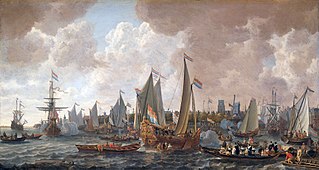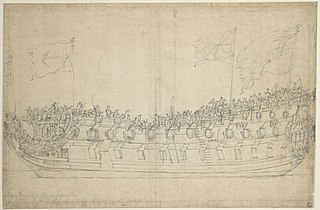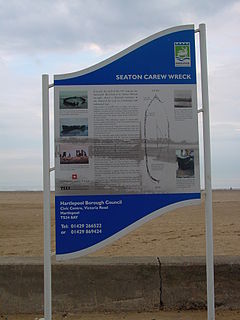The year 2004 in archaeology included many events, some of which are listed below.

Invincible was originally a 74-gun ship of the line of the French Navy launched in October 1744. Captured on 14 May 1747, she was taken into Royal Navy service as the third rate HMS Invincible. She was wrecked in 1758 after hitting a sandbank. The wreck is a Protected Wreck managed by Historic England.

HMY Mary was the first Royal Yacht of the Royal Navy. She was built in 1660 by the Dutch East India Company. Then she was purchased by the City of Amsterdam and given to King Charles II, on the restoration of the monarchy, as part of the Dutch Gift. She struck rocks off Anglesey in thick fog on 25 March 1675 while en route from Dublin to Chester. Although 35 of the 74 crew and passengers were killed as the wreck quickly broke up, 39 managed to get to safety. The remains were independently discovered by two different diving groups in July 1971. After looters started to remove guns from the site, a rescue operation was organized and the remaining guns and other artifacts were taken to the Merseyside Museums for conservation and display. After the passing of the Protection of Wrecks Act 1973, she was designated as a protected site on 20 January 1974.

HMS Resolution was a 70-gun third-rate ship of the line of the Royal Navy, launched at Harwich Dockyard on 6 December 1667. She was one of only three third-rate vessels designed and built by the noted maritime architect Sir Anthony Deane.

HMS Stirling Castle was a 70-gun third-rate ship of the line of the English Royal Navy, built at Deptford in 1679. She underwent a rebuild at Chatham Dockyard in 1699. She was wrecked on the Goodwin Sands off Deal on 27 November 1703. The wreck is a Protected Wreck managed by Historic England.
The Protection of Wrecks Act 1973 is an Act of the Parliament of the United Kingdom which provides protection for designated shipwrecks.

Hanover was a two-masted brigantine packet ship owned and operated by the Falmouth Post Office Packet Service, which operated between 1688 and 1852.

The Salcombe Cannon wrecksite is close to two other designated wrecksites in the Erme Estuary which the South West Maritime Archaeological Group (SWMAG) was licensed to investigate. In 1992 this group described the Salcombe Cannon site as:

The Seaton Carew Wreck is a protected wrecksite lying in the intertidal zone at Seaton Carew. Prior to 1996 the wreck had been completely covered by the sand of the beach, but it was exposed in 1996 and 2002 and has been regularly exposed since 2004. The wreck is of a type of vessel known as a collier brig which would have been ubiquitous in the 18th and 19th Centuries and is unusual on the North-East coast for the high degree of preservation. The wreck is a Protected Wreck managed by Historic England.
St Anthony or Santo António was a Portuguese carrack that foundered in Gunwalloe Bay, Cornwall, in 1527 en route from Lisbon to Antwerp. She had a mixed cargo including copper and silver ingots. The wreck was recorded historically, because the salvage of the cargo was the subject of an international dispute that led to a Court of Star Chamber, but the location of the wreck was unknown until 1981. The wreck is designated under the Protection of Wrecks Act and is managed by Historic England.
Cattewater Wreck is a wooden three-masted, skeleton-built vessel, one of many ships that have wrecked in Cattewater, Plymouth Sound, England. This wreck is close to the entrance of Sutton Harbour, its name is still unknown but it is believed to be from the 16th Century. It is a Protected Wreck managed by Historic England.
HMS Northumberland was a 70-gun third-rate ship of the line of the Royal Navy, launched at Bristol in June 1679.
Diamond was a three-masted square rigger, built in New York City in 1823. She was one of the first ships to operate a regular service for passenger and cargo between Britain and the United States. She sank en route to Liverpool from New York on 2 January 1825 in Cardigan Bay. The alleged wreck site was identified in 2000 and was designated under the Protection of Wrecks Act 1973 on 1 April 2002, the first such designation by the National Assembly for Wales. However, the identification has since been called into question.
The Wheel Wreck is the remains of a shipwreck lying in Crow sound off Little Ganinick in the Isles of Scilly. The wreck site consists of a discrete mound of cargo that appears to consist of numerous sizes of different iron wheels, cogs, clack valves, tubes and boiler pipes. Lead scupper pipes and other small artefact material show the ship was once present, however, not much remains of this vessel today. A Trotmann style anchor lies some 60m from the site, and this along with the cargo, date the site as sometime just after 1835. It has been published that this may be the wreck of the Padstow, however, being lost in 1804 this can not be so as neither boiler tubes or Trotmann anchors were invented back then. The wreck was discovered by local divers in 2005 and investigated by the archaeological contractor for the Protection of Wrecks Act 1973 in 2006. It still remains unidentified.

Coronation was a 90-gun second-rate ship of the line of the English Royal Navy, built at Portsmouth Dockyard as part of the '30 great ships programme' of 1677, and launched in 1685. She was lost in a storm off Rame Head, Cornwall on 3 September 1691 and is designated under the Protection of Wrecks Act 1973. The wreck is a Protected Wreck managed by Historic England.
The remains of an unknown wreck were discovered on Church Rocks, off Teignmouth in 1975. The site was designated under the Protection of Wrecks Act on 3 August 1977. The wreck is a Protected Wreck managed by Historic England.
A site consisting of tin ingots were found near West Mary's Rocks in 1991–1992. It is believed that these may represent a wreck site, or lost cargo from a ship. The ingots are believed to have been made before 1000 BC, and possibly as early as the Bronze Age. The site was designated under the Protection of Wrecks Act on 24 November 1993. The wreck is a Protected Wreck managed by Historic England. The ingots found here are an important source of knowledge for prehistoric tin.
The remains of an unknown armed cargo vessel dating to the sixteenth to seventeenth century were identified off Dunwich, Suffolk, England in 1993. The site was designated under the Protection of Wrecks Act on 12 July 1994. The wreck is a Protected Wreck managed by Historic England.
The remains of a Middle Bronze Age vessel were identified in Langdon Bay, Kent, England in 1974. The site was designated under the Protection of Wrecks Act on 25 May 1978. The wreck is a Protected Wreck managed by Historic England.
The remains of a seventeenth century cargo vessel were identified in Gunwalloe fishing cove, Cornwall in 1998. The site was designated under the Protection of Wrecks Act on 23 May 1999. The wreck is a Protected Wreck managed by Historic England.








